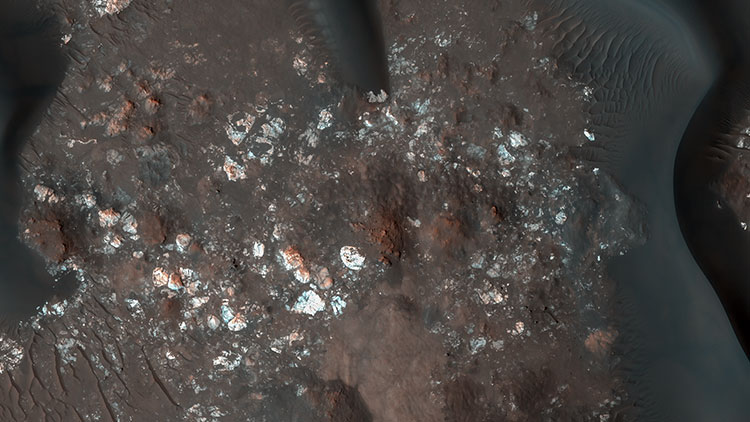#2 MARTIAN TERRAIN
Megabreccia in the Central Uplift of Stokes Crater.

Stokes is a large, approximately 60 kilometer diameter (38 miles) impact crater located in the Northern lowland plains of Mars.
Craters this large invariably have a central structural uplift, which form mountain peaks in or near the center of the crater. The Northern plains are largely covered by lavas and sediments, but craters such as Stokes allow us to observe the otherwise buried bedrock, exposed within its central uplift.
Megabreccia, consisting of very large fragments of pre-existing bedrock, is created by energetic processes, but especially by impact events on Mars. Although megabreccia deposits can coat central uplifts, it may not have been the Stokes impact that made this megabreccia.
The formation of a crater's central uplift does not commonly break up and jumble the deep bedrock. So if these megabreccias are exposures of the deep bedrock brought up to the surface by the central uplift, and are not merely deposits draped on the central uplift, then it is most likely that these megabreccias were created by much larger and older basin-forming impacts that now lie buried beneath the surface.
With the aid of high-resolution images, and especially the 3D anaglyphs, we hope to decipher whether the materials observed in the central uplift were formed by the host crater or prior to the formation of that crater. Either way, crater central uplifts can provide windows into the deepest and oldest geologic history of Mars. For example, if there was a very ancient ocean in the Northern lowlands, these rocks could include deposits from that ocean.
Written by: Alfred McEwen
Craters this large invariably have a central structural uplift, which form mountain peaks in or near the center of the crater. The Northern plains are largely covered by lavas and sediments, but craters such as Stokes allow us to observe the otherwise buried bedrock, exposed within its central uplift.
Megabreccia, consisting of very large fragments of pre-existing bedrock, is created by energetic processes, but especially by impact events on Mars. Although megabreccia deposits can coat central uplifts, it may not have been the Stokes impact that made this megabreccia.
The formation of a crater's central uplift does not commonly break up and jumble the deep bedrock. So if these megabreccias are exposures of the deep bedrock brought up to the surface by the central uplift, and are not merely deposits draped on the central uplift, then it is most likely that these megabreccias were created by much larger and older basin-forming impacts that now lie buried beneath the surface.
With the aid of high-resolution images, and especially the 3D anaglyphs, we hope to decipher whether the materials observed in the central uplift were formed by the host crater or prior to the formation of that crater. Either way, crater central uplifts can provide windows into the deepest and oldest geologic history of Mars. For example, if there was a very ancient ocean in the Northern lowlands, these rocks could include deposits from that ocean.
Written by: Alfred McEwen





